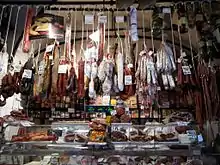Delicatessen
Traditionally, a delicatessen or "deli" is a retail establishment that sells a selection of fine, exotic, or foreign prepared foods. Delicatessen originated in Germany (original: Delikatessen) during the 18th century and spread to the United States in the mid-19th century. European immigrants to the United States, especially Ashkenazi Jews, popularized the delicatessen in U.S. culture beginning in the late 19th century. More recently, many larger retail stores like supermarkets have "deli" sections.

Etymology

Delicatessen is a German loanword which first appeared in English in the late 19th century and is the plural of Delikatesse.[1] The German form was lent from the French délicatesse, which itself was lent from Italian delicatezza, from delicato, of which the root word is the Latin adjective delicatus, meaning "giving pleasure, delightful, pleasing".[1] The first U.S. short version of this word, deli, came into existence probably after World War II (first evidence from 1948).[2]
History
The German food company Dallmayr is credited with being the first delicatessen created. In 1700,[3] it became the first store to import bananas, mangoes, and plums to the German population from faraway places such as the Canary Islands and China. Over 300 years later, it remains the largest business of its kind in Europe.[4]
The first delicatessens to appear in the United States were in New York City in the early 1880s, with the first advertised use of this word occurring in early 1884 in St. Louis, Missouri upon the opening of "Sprague's Delicatessen,"[5] at first one lunchroom and eventually five popular downtown lunch establishments operating between 1884 and 1906.[6] Early delicatessens in New York catered to the German immigrant population living there.[7] As the German-Jewish population increased in New York City during the mid- to late 1800s, kosher delicatessens began to open; the first was founded in 1889.[7][8][9] In the United States, by the late 20th to early 21st centuries, supermarkets, local economy stores, and fast food outlets began using the word (often abbreviated as "deli") to describe sections of their stores.[10] The decline of the deli as an independent retail establishment was most noted in New York City: from a high in the 1930s of about 1,500 Jewish delicatessens, only 15 still existed in 2015.[11]
By country and region
Australia

In most of Australia, the term "delicatessen" retains its European meaning of high-quality, expensive foods and stores. Large supermarket chains often have a deli department, and independent delicatessens exist throughout the country. Both types of deli offer a variety of cured meats, sausages, pickled vegetables, dips, breads, and olives.
In South Australia and Western Australia, "deli" also denotes a small convenience store or milk bar, and some businesses use "deli" as part of their business name. Traditional delicatessens also exist in these states, with "continental delicatessen" sometimes used to indicate the European version.
Canada
In Canada, both meanings of "delicatessen" are used. Customers of European origin often use the term in a manner consistent with its original German meaning, but as in the United States, a deli can be a combined grocery store and restaurant.
Europe

In Europe "delicatessen" means high-quality, expensive foods, and stores. In German-speaking countries a common synonym is Feinkost (fine food), and shops that sell it are called Feinkostläden (delicacy stores). Department stores often have a Delikatessenabteilung (delicacy department). European delicatessens include Fauchon in Paris, Dallmayr in Munich, Julius Meinl am Graben in Vienna, Harrods[12][13] and Fortnum & Mason in London, Peck in Milan, and Jelmoli in Zürich.
Although U.S.-style delicatessens are also found in Europe, they appeal to the luxury market. In Russia, shops and supermarket sections approximating U.S.-style delis are called kulinariya and offer salads and main courses. Delicate meats and cheeses, cold-cut and sliced hot, are sold in a separate section. The Eliseevsky food store in central Moscow, with its fin de siècle decor, is similar to a European delicatessen. From the Tsarist era, it was preserved by the Soviets as an outlet for difficult-to-obtain Russian delicacies. Delicatessens may also provide foods from other countries and cultures that are not readily available in local food stores. In Italy, the deli can be called gastronomia, negozio di specialità gastronomiche, bottega alimentare and more recently salumeria. In France it is known as a traiteur or épicerie fine.
Ireland
In Ireland, delis serve pre-prepared "food to go". This trend began in the 1990s and led to the emergence of many ready-to-eat deli products.[14] Delis can be found at a wide variety of convenience shops, newsagents, supermarkets, petrol stations, and casual eateries throughout Ireland.[15][16][17]
Popular items served at hot deli counters include chicken fillet rolls (breaded chicken fillet on a bread roll), breakfast rolls (Irish breakfast items on a bread roll), jambons, sausage rolls, and potato wedges.[14][18][19]
United States

In the United States, a delicatessen (or deli) is often a combined grocery store and restaurant, although the term may also be used for a strictly take-out or sit-down restaurant. Delis offer a broader, fresher menu than fast-food chains, rarely employing fryers (except for chicken) and routinely preparing sandwiches to order. They may also serve hot foods from a steam table, similar to a cafeteria. Although delicatessens vary in size, they are typically smaller than grocery stores.
American delis sell cold cuts by weight and prepare party trays. In addition to made-to-order sandwiches, many U.S. delicatessens offer made-to-order green salads. Equally common are prepared pasta, potato, chicken, tuna, shrimp, or other salads, displayed under the counter and sold by weight. Precooked chicken (usually roasted or fried), shrimp, or eggplant dishes (fried or parmigiana-style) are also sold. Delicatessens offer a variety of beverages, such as pre-packaged soft drinks, coffee, tea, and milk. Potato chips and similar products, newspapers, and small items such as candy and mints are also usually available.
Menus vary according to regional ethnic diversity. Although urban delis rely on ethnic meats (such as pastrami, corned beef, and salami), supermarket delis rely on meats similar to their packaged meats (primarily ham, turkey, and American bologna). American delicatessen distribution is primarily in older, pedestrian-friendly cities. Delicatessens from a number of cultures can be found. In the United States, many are Italian, Greek, or Jewish, both kosher and "kosher style". The American equivalent of a European delicatessen may be known as a gourmet food store.
Deli may refer to a kosher deli or kosher-style Jewish deli.
See also
- Appetizing store
- Charcuterie
- List of delicatessens
- Osteria
- Pastrami on rye – a classic sandwich made famous in the Jewish kosher delicatessens of New York City
- Salumeria
- Salumi
- Save the Deli – a book about the decline of the Jewish delicatessen
- Specialty foods
- Traiteur
- Trattoria
References
- "Deli". U.S. Heritage Dictionary. Retrieved 18 September 2021.
- "Deli". merriam-webster.com. Merriam-Webster. Retrieved 16 April 2016.
- "Step by step to success". www.dallmayr.com. Archived from the original on 5 October 2015. Retrieved 5 October 2015.
- History of New York Delis (Report). pastramiblog.blogspot.com. 2009. Retrieved 16 April 2016.
- St. Louis Daily Globe-Democrat, Sunday Morning, 23 March 1884 p.2
- St. Louis Post-Dispatch, 21 February 1906, p.1
- Tracing The Path Of The 'Deli Man' Across North America (Report). NPR. 15 February 2015. Retrieved 13 April 2016.
- Kriftcher, Noel (2009). Review: Save the Deli (Report). Jewish Book Council. Retrieved 13 April 2016.
- Sokan, Kenny (31 March 2016). Pastrami on rye: A full-length history of the Jewish deli (Report). Public Radio International. Retrieved 16 April 2016.
- Naylor, Tony (16 March 2010). "The Deli Directive". The Guardian. Retrieved 16 April 2016.
- "The rise and fall of the Jewish deli". The Economist. 15 December 2015. Retrieved 16 April 2016.
- "Are pork scratchings going posh? - BBC News". BBC News. 20 June 2015. Retrieved 11 April 2016.
- "Delicatessens in Knightsbridge, Central London | Reviews – Yell". Trustedplaces.com. Archived from the original on 5 October 2008. Retrieved 7 October 2015.
- Devery, Caitriona (27 October 2020). "Mysteries of the Deli: The Jambon". District Magazine. Retrieved 7 April 2021.
- McWilliams, David (22 October 2009). David McWilliams' Follow the Money: David McWilliams Ireland 2. Gill & Macmillan Ltd. ISBN 9780717155576 – via Google Books.
- Anderson, Heather Arndt (11 July 2013). Breakfast: A History. AltaMira Press. ISBN 9780759121652 – via Google Books.
- McWilliams, David (11 January 2011). The Pope's Children: The Irish Economic Triumph and the Rise of Ireland's New Elite. John Wiley & Sons. ISBN 9781118045374 – via Google Books.
- Brent, Harry (8 October 2020). "Ireland's favourite deli food has been revealed - and it's hardly a surprise". The Irish Post. Retrieved 11 January 2022.
- McDonald, Brian (12 May 2008). "Top breakfast baguette rolls into Irish history". Irish Independent. Retrieved 3 February 2019.
Further reading
- Merwin, Ted. Pastrami on Rye: An Overstuffed History of the Jewish Deli (New York University Press, 2015.) xviii, 245 pp.
External links
- "Deli Paradise Travel Guide". Travel Channel.
- Los Angeles Delis. Thrillist.
- New York Delis. Time Out.